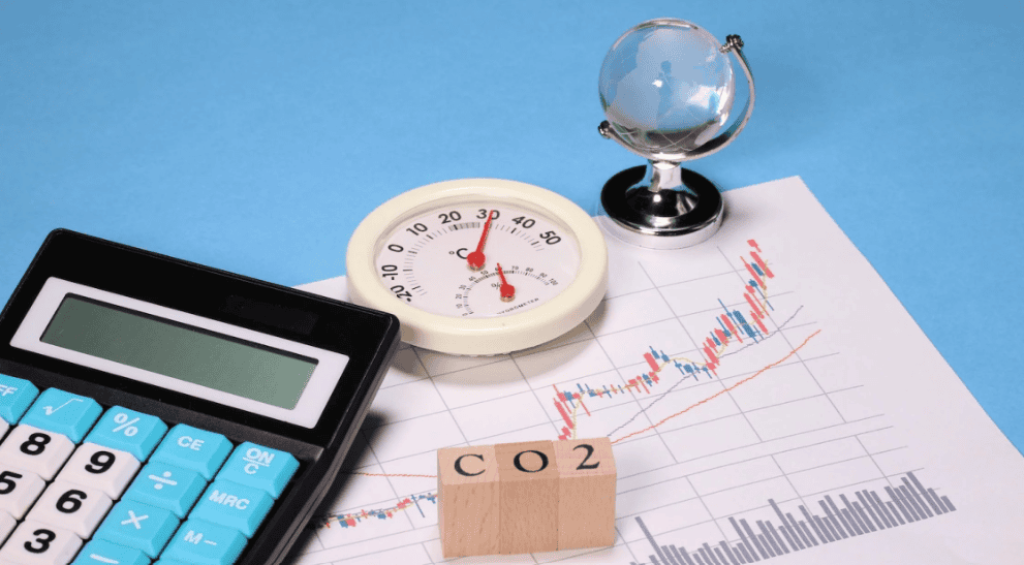Productivity growth has been lacklustre over the past 20 years in most advanced economies. But standard productivity measures ignore the progress that some economies have made in terms of lowering carbon dioxide emissions. This column proposes a method to embed those efficiency gains into existing productivity measures. For traditional (small) estimates of the cost of climate change, the adjustment to productivity for emissions is small. When quantified using recent (high) estimates of the economic costs of climate change, emissions-adjusted productivity growth has accelerated – rather than slowed down – in recent years.
Since the mid-2000s, productivity growth in many advanced economies has consistently fallen short of the rates observed in previous decades (Winkler et al. 2021). In the United States, for instance, growth has averaged around 0.5% per year, compared to 1.5% between 1990 and 2005 (Figure 1a). The slowdown has been even more pronounced in Europe (Draghi 2024). This sluggish growth has raised serious concerns among both academics and policymakers, given that productivity accounts for approximately 80% of per capita income growth in advanced economies (Jones 2016).
Standard productivity statistics do not, however, take into account that economies have become less reliant on carbon dioxide emissions. Although carbon emissions remain too high to meet climate goals in many places, emissions have declined significantly since the mid-2000s in many advanced economies, and especially so in the US. Absolute US carbon emissions fell by 23% between 2005 and 2024 (Figure 1b), while the ratio of carbon emissions over GDP declined by 40%. The decline is similar in magnitude when measured based on territorial emissions – those arising from domestic production, and consumption-based emissions – which account for rising international trade and imported emissions from countries such as China (Andrew and Peters 2024).
An efficiency improvement that reduces carbon emissions will not be picked up by standard productivity measures because emissions change neither measured inputs nor measured output. But lower carbon emissions today prevent climate damages in the future. Recent estimates suggest that these damages are very large: a metric ton of carbon emissions, which is roughly the emissions associated with a one-way economy flight from London to New York, does around $1,300 of damage to the present value to future consumption (Bilal and Kanzig 2024, 2025). How should we adjust productivity statistics to capture the fact that production now comes with lower carbon emissions?
Figure 1 Productivity growth and US carbon emissions


Note: The left-hand figure plots productivity growth adjusted for utilisation (Fernald 2014). The right-hand figure plots US carbon dioxide emissions (Andrew and Peters 2024). Five-year centred moving averages.
Emissions-adjusted total factor productivity
In a new paper, we propose a method to adjust productivity growth for changes in carbon dioxide emissions (De Ridder and Rachel 2025). Emissions-adjusted total factor productivity (TFPE) measures how efficiently the economy transforms inputs into the present value of consumption, accounting for the negative impact of carbon emissions on future output and factor accumulation. Standard total factor productivity (TFP), by contrast, measures how efficiently inputs are converted into current output.
TFPE and TFP are closer than they may seem, in the sense that both productivity measures relate inputs today to present value of consumption. For TFP, that is because current output (in the numerator) consists of both consumption and investment goods, and the latter enable future consumption. When investment goods are competitively priced, their prices reflect the present value of the future consumption they enable. This insight, developed in the classic work by Weitzman (1976), is why aggregate output – when measured net of depreciation – is a welfare-relevant indicator of economic activity. TFPE expands the way that productivity is measured by not only looking at the efficiency at which inputs are transformed into consumption and investment goods, but by also taking into account the negative effects of emissions on output.
To do so, we build closely on the macro-climate literature and derive an expression for TFPE in a framework that nests seminal models including the well-known integrated assessment model by Nordhaus (1992). TFPE is straightforward to calculate and only requires data on aggregate output, carbon emissions, TFP, as well as an estimate of the social cost of carbon. The first three are available for most countries for many years in public datasets such as the Penn World Table (Feenstra et al. 2015). The latter measures the marginal change in the present value of future consumption per unit of emissions, and is a frequently estimated object in empirical work on the economic effects of climate change. It acts as a ‘sufficient statistic’ that translates the emissions-intensity of production in consumption terms.
Figure 2 Productivity growth in the United States (five-year moving average)


Note: TFP is productivity from the Penn World Table, TFPE is emissions-adjusted productivity for two values of the social cost of carbon (De Ridder and Rachel 2025).
No slowdown in US TFPE
The social cost of carbon directly affects the TFPE estimates. For low social costs, TFP approximately equals TFP. This has a natural interpretation: if the social cost of carbon is small, the benefits of an increase in (traditionally measured) productivity dominates the negative effects of carbon-induced climate change. This is particularly the case if the social cost is measured without taking the global damages from domestic emissions into account. This ‘domestic’ cost of carbon is not usually used for climate policy analysis (Stern et al. 2022), although US policy during the 2017-2021 Trump administration is a notable exception.
De Ridder and Rachel (2025) present estimates of TFPE for two values of the social cost of carbon. Both values take global climate damages into account. The first value is $252 in 2017 US dollars per metric ton of carbon, taken from a meta analysis by Moore et al. (2024). The second value is $923, which is the value that Bilal and Kanzig (2024) estimate from regressing shocks to global average temperatures on global economic activity. Data on output and TFP comes from the Penn World Table and consumption-based carbon emissions are taken from the Global Carbon Project.
Has there been a slowdown of growth once emissions are taken into account? The path of US TFPE is plotted in Figure 2. The figure shows the well-known abrupt slowdown of productivity growth in the mid-2000s when measured through TFP. Adjusted for emissions, however, the slowdown is milder. For the lower social cost of carbon (red-dashed lines), the plot already shows that growth in the 1990s was lower than standard metrics suggests. This is because carbon intensity was rising over those years. The opposite happens after 2005: TFPE growth exceeds TFP growth, because emissions fell.
For the higher estimates of the social cost of carbon (green solid lines), the reduction in emissions causes a rise in productivity growth that is large enough to undo the entire slowdown of the mid-2000s. If anything, productivity growth accelerates over the past 20 years.
The recent high estimates of the social cost of carbon which underlie these calculations are clearly outliers relative to the rest of the literature, and the debate on what the true costs are is likely to continue over the years to come. Nonetheless, it is worth stressing that even these high estimates of the cost of carbon only focuses on narrow economic costs to consumption. Changes in broadly defined welfare by factors such as higher migration or old-age mortality, for example, are not considered (Carleton et al. 2022). If these non-consumption costs of climate change are included in the definition of TFPE, the resulting social cost of carbon is high even if the economic costs are more modest.
Adjusting productivity for emissions also changes cross-country patterns. While most European economies have paths of emissions that look similar to the US, the path of emissions in countries like China and South Korea is considerably different. While their emissions intensity has recently been falling, these countries saw rapid increases in emissions between 2000 and 2020, also when only focusing on the consumptions associated with domestic consumption. The future climate damages associated with these emissions are so large that TFPE growth in both countries was negative for most of the past decade.
Conclusion
Carbon emissions have been falling in many advanced economies, but standard productivity statistics do not take the future benefits of cleaner production into account. For high estimates of the damages done by carbon dioxide, US TFPE growth has accelerated rather than stagnated since 2005. Efficiency of production is therefore still rising, but to the benefit of future global consumption rather than domestic output today.
The framework that we use to calculate TFPE can be readily extended to other variables that also affect future output. Because of its spillovers, for example, investments into research and development are likely to have (much) greater positive effects than their prices in the national accounts imply. The same is true for factors like human capital accumulation. As noted by Weitzman (1976), such factors should be taken into account to assure the welfare relevance of macroeconomic aggregates. Quantifying the path of productivity while accounting for such variables is an exciting avenue for future work.
Source : VOXeu



































































